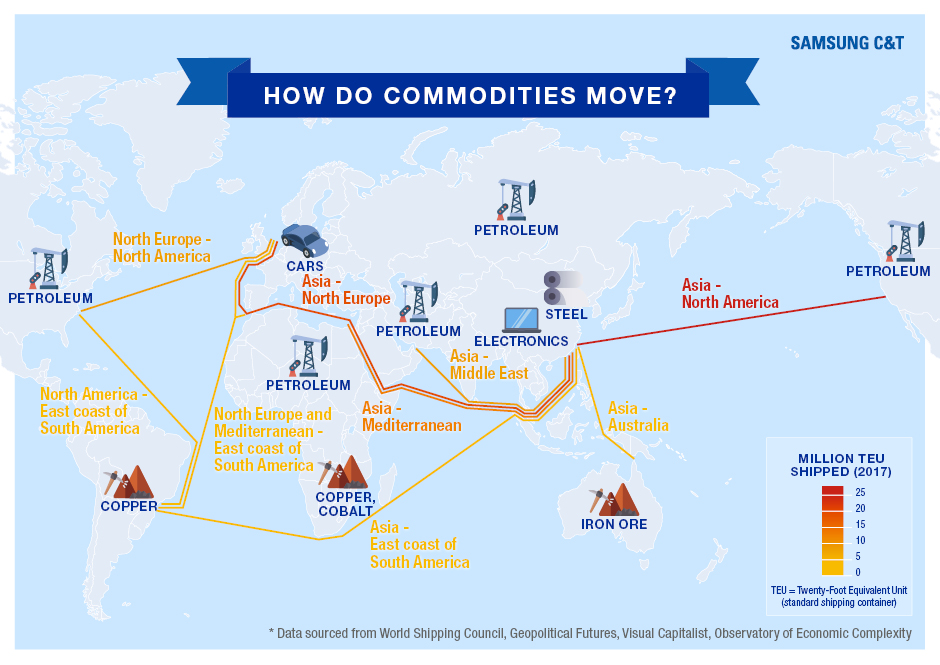What kind of device are you using to read this article? Whether it is a smartphone or a laptop, one thing is certain: that device was not produced from scratch in just one country. For example, the lithium in the battery of your phone may be from Chile, while it is quite possible that each component was assembled in a factory located in Southeast Asia, and you could have bought it just about anywhere in the world.
The importance of logistics is that it forms a global chain linking all the parts of production, supply, and consumption together. On that point, recently when a large ship got stuck for almost a week in the Suez Canal, the cost was felt far and wide, with about 12% of global trade passing through the canal every day. Its blockage also held up an estimated USD 9.6 billion of trade each day until it was cleared – or USD 6.6 million per minute! This feature will look more closely at the global logistics chain.
Via sea or air? A question of timing
Land, maritime, and air transportation all play vital roles in logistics. Among them, we will focus on the latter two in this feature.
Maritime transportation stretches back thousands of years, but it remains a major part of global trading. It allows the movement of a huge amount of commodities including crude oil, iron ore, grains, chemicals, and even manufactured goods. The major advantage is that it offers much cheaper prices than air transportation, and even road and rail. Shipping containers have also become both iconic and practical, being easily transferrable to trucks and trains.
By comparison, aviation freight has obviously only been facilitated by the advent of air travel generally. It is more costly than maritime logistics, but is seen as a good way to move time-sensitive goods such as documents, pharmaceuticals including vaccines, fashion garments, production samples, electronic consumer goods, and perishable agricultural and seafood products.
The infographic below shows major logistics routes and what kind of trade they support.
The rewards and risks of global logistics
The modernization of transport and logistics has brought vast benefits to trade and the availability of consumer goods worldwide, connecting the world to each other more closely.
As an example, the import of fresh fruit to the U.S. increased by USD 8.9 billion in 2019 compared to 2009, allowing Americans to enjoy them throughout the year regardless of season. This kind of trade is possible thanks to the development of logistics, including cold chain technology.
Another feature of globalization is how the process of sourcing materials, manufacturing goods, and selling them can take place across numerous countries – creating longer and more complex supply chains. This is especially true of tech-heavy products with many, varied parts.
The Suez and Panama Canals are also good cases of logistics advancements, significantly cutting shipping times and distances. The Suez Canal has shortened the journey from Asia to Europe, saving 7 to 10 days of shipping time, while the Panama Canal has reduced maritime distances between the East and West Coasts of the U.S. by 13,000 kilometers.
One thing to keep in mind is that these logistics chains come with risks attached. The recent Suez Canal blockage and the impact of COVID-19 might seem like rare cases, but significant problems do happen fairly regularly – companies across industries can expect supply chain disruptions every 3.7 years. In the case of maritime transport, logistics can be delayed by floods and drought, piracy, disrepair, and so on. Air freight does not escape risks either – partly because it is part of a longer chain and partly because specific factors like environmental regulations and oil prices need to be continuously considered.
Preparation is key for Samsung C&T
As logistics forms an important part of the global supply chain as shown above, companies make efforts to mitigate risks as far as possible and guarantee timely deliveries. For example, purchasing insurance is one of the ways to prepare for potential problems. In fact, the global marine insurance market is expected to grow by USD 8.42 billion by 2024, at a CAGR of over 4%.
As a trading company, Samsung C&T also works as efficiently in this area. “We are endeavoring to respond to and reduce risks by securing as many logistics routes as we can,” explains Principal Professional Kim Kyoo-hak, head of the Corporate Logistics Planning Group of T&I Group. “We also secure adequate insurance to hedge risks, while generally looking for more efficient ways to transport goods.”
Knowing about all these efforts may make it feel that bit more special to use our various smart gadgets – or even make imported fruit taste that much sweeter!








